George Adamski Got Famous Sharing His UFO Photos and Alien ‘Encounters’
He claimed to have conversed with Venusians using hand gestures and mental telepathy.
To some, he was a prophet. To others, a laughing stock. Even today, more than half a century after his death, George Adamski remains one of the most curious and controversial characters in UFO history.
Adamski had multiple claims to UFO fame. Starting in the late 1940s, he took countless photos of what he insisted were flying saucers. But experts, including J. Allen Hynek, scientific consultant to the Air Force’s Cold War-era UFO investigation team Project Blue Book, dismissed them as crude fakes.
Then, in 1952, Adamski reported that he had met and conversed with a visitor from Venus in a California desert, using a combination of hand gestures and mental telepathy.
His story would only get stranger from there.
A star gazer is born
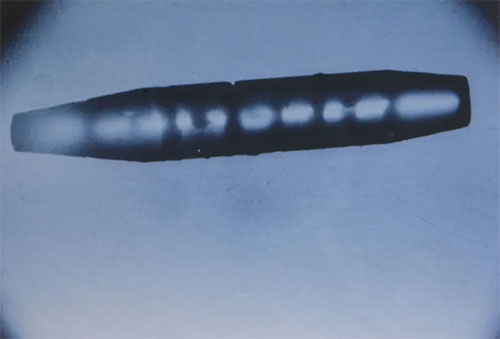
A cigar-shaped Venusian interplanetary carrier photographed through a 6″ telescope over Palomar Gardens, California taken by Adamski.
Adamski chronicled his alleged adventures in several books. The first, Flying Saucers Have Landed (1953), coauthored with Desmond Leslie, recounted his chat with the Venusian. Widely read at the time, it later gained a new generation of fans in the trippy 1960s.
Adamski’s 1955 sequel, Inside the Space Ships, described further meetings, not only with the Venusian but also with emissaries from Mars and Saturn. In Adamski’s telling, every planet in our solar system was populated with human-like inhabitants, as was the dark side of the earth’s moon.
In the 1955 book, Adamski claimed that his new friends took him aboard one of their scout ships, flew him to an immense mother ship hovering over the earth, gave him a ride around the moon and treated him to a colorful travelogue about life on Venus.
Along the way, he was also tutored by a space man he called ‘the master.’ ‘The master’, who was said to be nearly 1,000 years old, shared the secrets of the universe with Adamski, only some of which he was allowed to divulge back on earth.
Preposterous as his stories seemed, Adamski became an international celebrity and lectured widely. Queen Juliana of the Netherlands raised a public stir after inviting him to her palace in 1959 to discuss extraterrestrial doings. Adamski supposedly claimed a secret 1963 meeting with the pope, as well.
Adamski soon had followers all over the planet. But not everybody was on board. Arthur C. Clarke, the author of 2001: A Space Odyssey, not only denounced Adamski’s work but characterized his believers as “nitwits.”
Who was George Adamski?
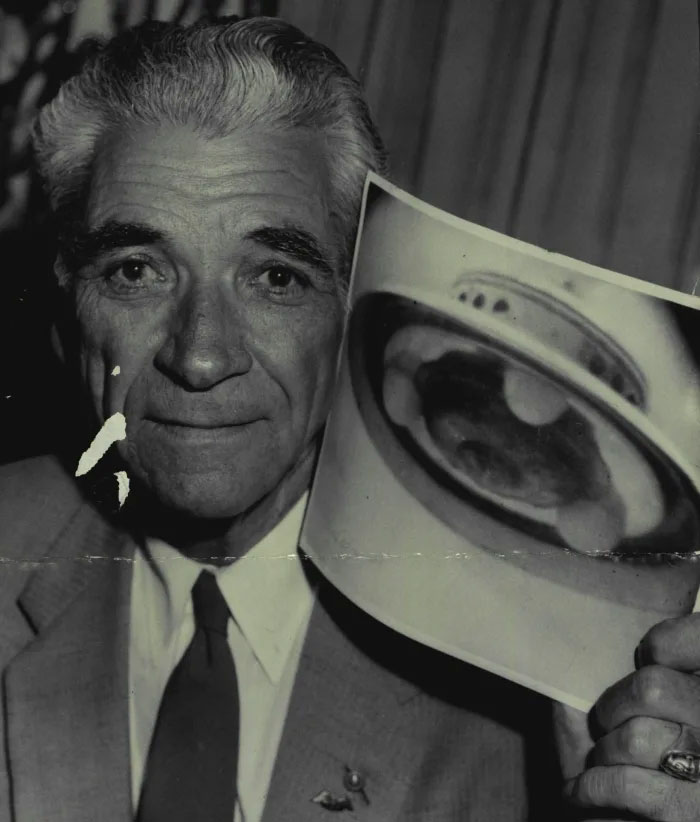
George Adamski with a photograph of a Venusian Scout on February 18, 1959.
George Adamski was reportedly born in Poland in 1891, came to the U.S. with his parents at as a young boy and grew up in far-northern New York state.
He seems to have had little formal education, though the press would later refer to him as “Professor Adamski”.
Adamski enjoyed his first glimpse of glory in 1934 as the leader of a group calling itself the Royal Order of Tibet. The Los Angeles Times reported they had bought an old estate in Laguna Beach, California, and planned to establish the first Tibetan monastery in America on the site. The Times described “Prof. George Adamski” as being “as strange as the cult he sponsors.”
Somehow, Adamski convinced the reporter he had lived in the “ancient monasteries” of Tibet as a child. “I learned great truths up there on ‘the roof of the world,’” he was quoted as saying.
In 1936, he was back in the papers again, this time as the leader of a group called Universal Progressive Christianity, whose international headquarters, he said, would soon be established in Laguna Beach.
Aside from offering a tax plan to end the Great Depression in 1938, the “professor” stayed out of the news until after World War II. But when the postwar UFO craze took off, Adamski hopped right on.
Eyes on the skies
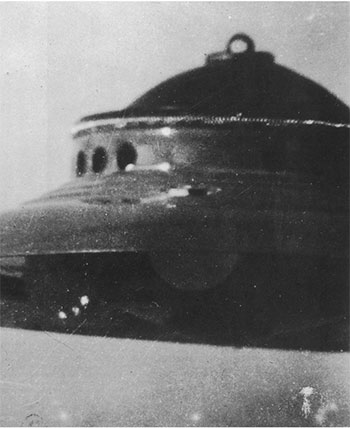
A Venusian ‘scout craft’ photographed by George Adamski, 1952.
In October 1946, he said, he spotted his first UFO – “a large black object, similar in shape to a gigantic dirigible, and apparently motionless.”
His next sighting came in August 1947. This time, it wasn’t just a single object but a procession of them – at least 184 by his count. Then, in late 1949, at what he said was the urging of the U.S. military, he attached a camera to his six-inch telescope and began scanning the skies at every opportunity. Soon he had what he considered two good UFO pictures.
“Since then, winter and summer, day and night, through heat and cold, wind, rains and fog, I have spent every moment possible outdoors, watching the skies,” he wrote.
By the end of 1952, the skies over his California home had become a sort of UFO shooting gallery. Adamski estimated he took another 500 flying saucer photos, from which he got a dozen good ones. He claimed to have provided prints to the Air Force, but he kept the negatives.
A close encounter of the Venusian kind
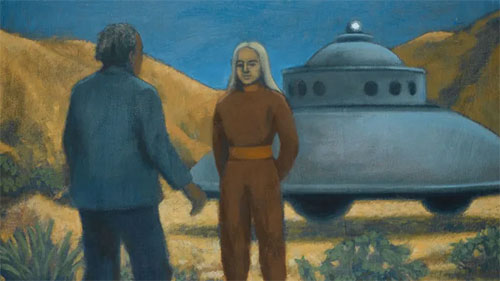
A painting depicting an encounter with a visitor from Venus at Desert Center, California, 1952.
It was in November 1952, in a remote patch of California desert, that Adamski came face to face with his supposed visitor from Venus. “The beauty of his form surpassed anything I had ever seen,” Adamski wrote. “And the pleasantness of his face freed me of all thought of my personal self. I felt like a little child in the presence of one with great wisdom and much love…”
The Venusian’s flesh was as soft as a baby’s, Adamski reported after they touched palms, while his “hair was sandy in color and hung in beautiful waves to his shoulders, glistening more beautifully than any woman’s I have ever seen.”
When the two finally got around to communicating, it became clear that the Venusian had come to deliver a message. Earthlings should stop messing around with atomic bombs, he told Adamski, before they destroyed their entire planet. To punctuate his point, and to show that he had picked up at least one word of English, the alien added, “Boom! Boom!”
Adamski wasn’t the first American to claim he’d met an alien, but he was the first to go public, and he quickly became the most famous “contactee.” Countless others would follow in the decades to come, telling their own tales of what Project Blue Book’s Hynek famously labeled “Close Encounters of the Third Kind.”
His new notoriety turned the humble restaurant where he worked into a tourist attraction. One visitor was Edward J. Ruppelt, then head of Project Blue Book, who dropped by, incognito, in 1953 to find Adamski holding court and hawking copies of his UFO pics. “To look at the man and to listen to his story, you had an immediate urge to believe him,” Ruppelt wrote in his 1956 book The Report on Unidentified Flying Objects, adding that he had “the most honest pair of eyes I’ve ever seen.”
Hynek also paid a visit to Adamski’s eatery, along with some fellow astronomers. Although he tried to engage Adamski on more scientific matters, Hynek later recalled, “All he wanted to do was sell me photos.”
Con man, crackpot or cosmic messenger?
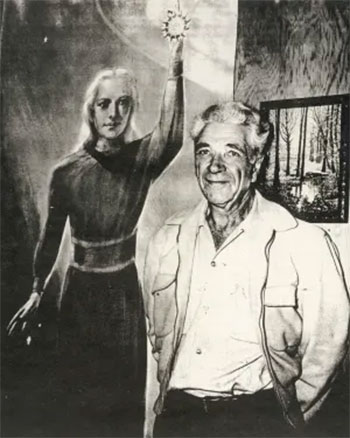
George Adamski stands in front of a painting by Gay Betts depicting the Venusian space pilot he met in the Mojave Desert, California.
Adamski published at least one more book, Flying Saucers Farewell (1961) and continued to lecture widely.
Adamski stuck to his story to the end – including the upbeat but somehow ominous message he’d delivered in Flying Saucers Have Landed:
“My most urgent message and plea to every person who reads it is: Let us be friendly. Let us recognize and welcome the men from other worlds! THEY ARE HERE AMONG US.”
yogaesoteric
March 20, 2020
